Hyundai Verna vs Skoda Slavia vs Volkswagen Virtus: Performance incentive
The performance benchmarks in the midsized sedan segment have evolved and that’s thanks to the three models you see here.
Published on Jun 27, 2023 08:00:00 AM
55,331 Views
Follow us on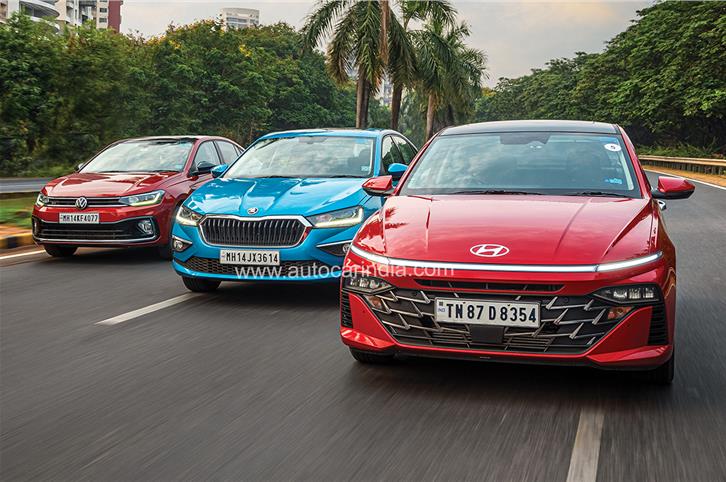
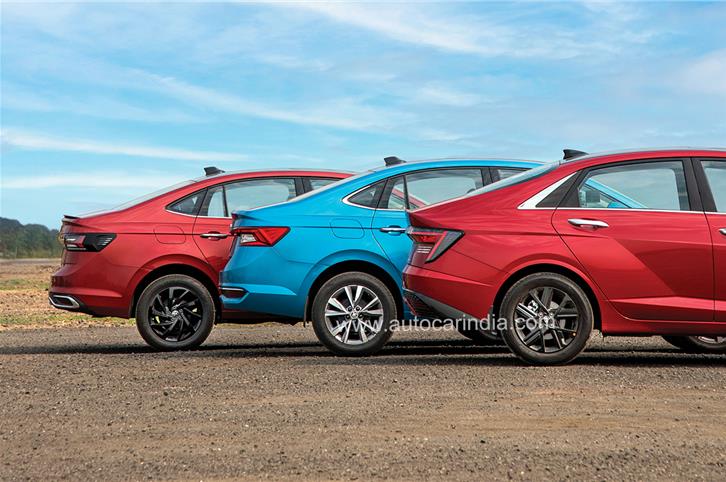
While the Hyundai Verna, Skoda Slavia and Volkswagen Virtus are each available in level-headed (read lesser-powered versions), this comparison is all about their spiciest iterations. Meet the 160hp Hyundai Verna Turbo that’s sharing road space with the 150hp Skoda Slavia 1.5 TSI and the 150hp Volkswagen Virtus GT. These are sedans that will lure you to spend more over their mainstream versions for the added performance they pack in. Ardent petrolheads will sure find the added money well spent.
All three sedans come powered by 1.5-litre direct-injection, turbo-petrol engines and can be had with 6-speed manual gearboxes. For this comparison, we’ve opted for their 7-speed dual-clutch transmission versions that blend engagement with convenience. What makes the competition all the more interesting is that these are all new cars. The Slavia is the oldest of the trio and it’s just been on sale since February last year. That’s the back story. Let’s get to the competition.
Hyundai Verna vs Skoda Slavia vs Volkswagen Virtus: Performance
There have been lots of fine driving Skodas and Volkswagens, but the list of entertaining Hyundais is a short one. Which is why there is added curiosity about the Verna Turbo. First impressions are of a friendly car, occasional low-speed fumbles from the gearbox notwithstanding. Power delivery is linear and likeable. Thing is, the genteel build of speed hides how strong the Hyundai engine is across the rev range. Sure, the engine only revs to 5,800rpm so you don’t get that top-end rush, but, on the other hand, you also don’t need to get it all worked up to get the most out of it. It’s an engine that’s easy to exploit and, as a plus, the gearbox also feels satisfyingly quick in higher speed settings, both in auto mode and via manual inputs at the paddles or gear lever.
That the Verna is deceivingly quick is reflected in its performance numbers. Its 8.82sec 0-100kph time is the best here, if by the smallest of margins, and in kickdown acceleration too, there’s little between the Verna and the VW Group twins.
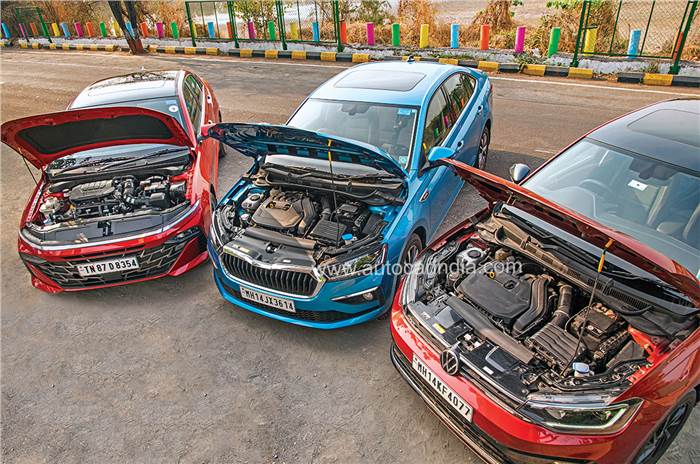
As you may know, the Slavia and Virtus are one and the same under the skin, so the following driving impressions hold true for both. The Volkswagen Group’s 1.5 TSI engine is slightly down on power to the Hyundai unit, but many will actually find it to be the more exciting powerplant. And that’s down to how it bunches up its power in the mid-range to deliver a satisfying punch. It’s got the freer top end too. The engine will happily rev to 6,200rpm and sounds quite nice while doing all that it does. In fact, the sensations make the Virtus and Slavia feel quicker than the numbers would suggest. The 7-speed DSG dual-clutch gearbox plays its supporting role really well when you’re going for it, delivering quick shift after quick shift with slickness. Trouble is, the very same gearbox can feel hesitant in low speed city settings.
Unique to VW’s 1.5 TSI engine is cylinder deactivation tech. At light loads, the system switches off two cylinders for best efficiency. What’s remarkable is that the switch from four to two and back to four cylinders goes unnoticed and it’s only a notification on the instruments that will tell you what’s happening behind the scenes. In our tests, the Slavia and Virtus managed 9.3kpl in town and 15.6kpl on the highway. The Verna delivered better numbers with 10.6kpl in town and 16kpl on the highway. Perhaps the lighter throttle needed in the Verna is to credit for the better numbers.
Hyundai Verna vs Skoda Slavia vs Volkswagen Virtus: Ride and handling
Straight line performance is one thing. Could the Verna have closed the gap to its European rivals, or even surpassed them in handling? Drive modes that add weight at the steering (and also quicken throttle responses) with each successive mode help fine-tune the driving experience, but even at its sportiest, the Verna doesn’t suck you into the experience. There is a reasonable amount of weight at the steering, but it’s still not the last word in feel and connect. Mind you, the steering is not a deal breaker as it was on older Vernas and you can actually enjoy yourself on a winding road. But soon enough you’ll reach the limits of the suspension that comes across as a bit too soft for something meant to be sporty. Perhaps Hyundai wants to leave some breathing room for a souped-up N-Line version.
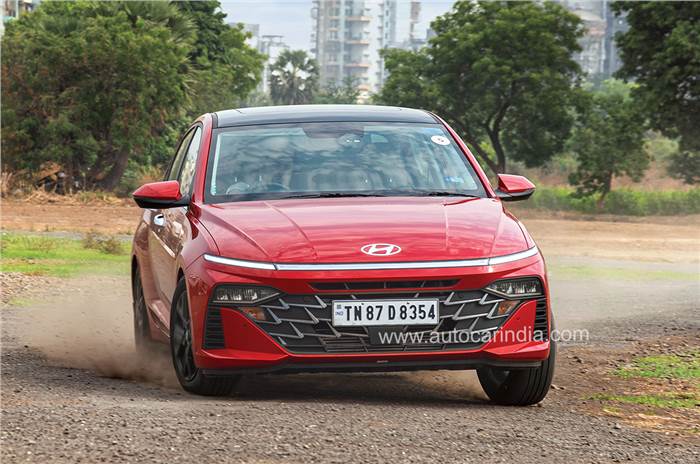
On the same roads, it’s the Virtus and Slavia that feel more involving to drive. Their steerings are light, but there’s a good amount of precision that really helps you work a connect with the cars. The duo also change direction with greater poise and allow you to hold higher speeds with more confidence. Body movements are better contained and that’s despite the SUV-like 179mm of ground clearance.
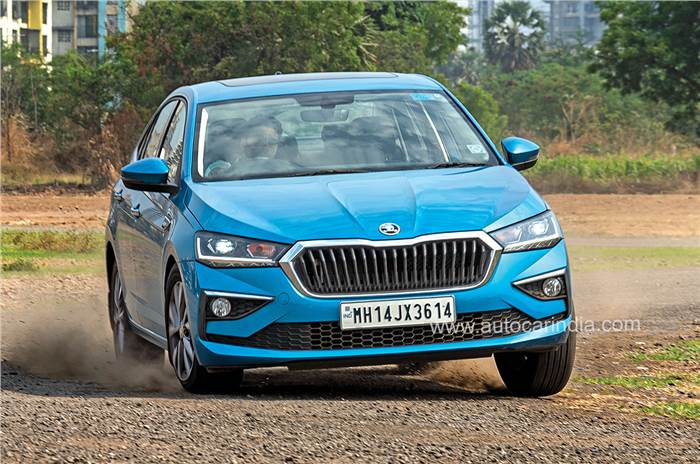
The Virtus and Slavia also feel more surefooted under hard braking, although it’s the Verna with discs at all four wheels that has the shorter stopping distance. Where the Verna has the clear edge is in refinement. It does a better job of isolating you from the world outside and the cushier low speed ride also helps to this end. Go fast over a pothole, though, and you will hear a loud thwack from the Verna’s suspension. The Virtus and Slavia are comfortable in their own right, but after a go in the Verna, you will notice more of the road below you.
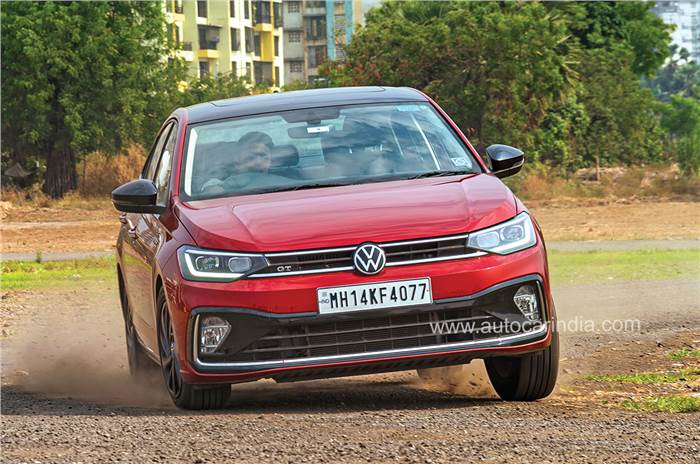
Hyundai Verna vs Skoda Slavia vs Volkswagen Virtus: Interior
It’s the Hyundai Verna that draws the most eyeballs though not always for the right reasons. Some love the rad style, others loathe it. To my eyes, the fastback-like shape works, but the flat front end with its light bar and gaping grille is out of sync with the high deck boot. The clean-cut Slavia and Virtus are more conventional in look and both carry their respective brand’s identities very strongly. But don’t you think Skoda could have been a bit more adventurous with the 1.5 TSI? It looks exactly the same as the lesser 1.0 TSI. A Slavia Monte Carlo would immediately up the wow factor. Volkswagen has made more of an effort in this regard with the 1.5 TSI that’s sold in GT form. Its blacked-out wheels, blackened roof, black mirrors and lip spoiler establish it as something special.

Inside, the Verna makes a great first impression. The low dash cowl lends the cabin an airy feel, the centre console angled towards the driver looks sporty and the twin-screen layout is new-age. But it’s not perfect. The front seats aren’t generous for larger framed occupants, and, as sporty as the Turbo’s all-black theme is, many surfaces feel hard and look shiny.

You sit noticeably higher up in a Virtus and Slavia and the reassuring thunk on door shut makes for a welcoming sound. There’s a robustness inside too though overall quality isn’t up there with the pricier Volkswagens and Skodas. The duo share many elements including the large front seats, but the distinct dashboards help give the cousins a personality of their own. It’s the Virtus GT that puts you in a sporty frame of mind with its red theme that includes a red outline for the dashboard. The Slavia’s interior looks classy, but again, there’s nothing to tell you this is the high-powered version, which is a bummer. Do note, the Slavia pictured here has a 10-inch touchscreen, while models on sale come with a nice enough 8-inch unit. The semiconductor crisis forced Skoda to settle for a smaller size, but the bigger screen will be back soon.
Hyundai Verna vs Skoda Slavia vs Volkswagen Virtus: Features
Talking features, all three cars get you enough goodies. Digital dials, slick touchscreens, ventilated front seats, leatherette upholstery and single-pane sunroofs are part of the package on all three models.

The Verna does go one up on its rivals packing in added features like partial power adjust for the driver’s seat, front seat heating (very useful on cold winter days), adjustable ambient lighting and an electronic parking brake. A cool inclusion on the Verna is a switch that lets you toggle the centre console buttons to either operate the audio system or climate control system. It’s a clever function that retains physical controls for oft-used features. In comparison, the Slavia’s and Virtus’ climate control touch panel isn’t easy to use on the go. Of the other things, the Verna’s Bose sound system is good but we found the Skoda sound system to deliver the deepest sound.

In terms of safety features, these cars pack in six airbags, ABS, electronic stability control and Isofix child seat mounts. While all three comply with the latest Indian crash test norms, they go over and above prevailing regulatory requirements in different ways. The Slavia and Virtus have bragging rights with 5-star scores in Global NCAP’s adult and child occupant protection parameters. The Verna hasn’t been tested by Global NCAP as yet, but it is the only one here with radar- and camera-based advanced driver assistance systems or ADAS that can help prevent an accident altogether. I’m not fully comfortable with features like lane keep assist, but adaptive cruise control is a boon and auto emergency braking can be a life saver. The Verna’s crisper rearview camera deserves mention too.
Hyundai Verna vs Skoda Slavia vs Volkswagen Virtus: Rear seat
In terms of rear seat space and comfort, it’s a close match. All three offer ample legroom to accommodate sixfooters with ease, though the said occupants will find their hair brushing the roof lining in each of the sedans. Also, while there are three-point rear seat-belts for the middle passenger (the Virtus and Slavia also get a dedicated headrest), none of the cars is wide enough to seat three in absolute comfort. The Verna does have the most comfortable backrest angle and the rear windscreen blind is also a big help on hot days.

All cars offer AC vents at the back as well as USB charging ports. You won’t be left wanting for storage spaces either with bottle holders on the doors and cup holders at the rear armrests. Large and usable gloveboxes and storage around the centre console offer enough place for smaller items up front. In terms of luggage space, the three sedans have you covered. It’s the Verna that has the largest boot on paper offering 528 litres to the Virtus and Slavia’s 521 litres, but the fact is all can accommodate large suitcases with ease. The Virtus and Slavia do go one up on the Verna with the added versatility of 60:40 split rear seats for times when you need to transport long items or just need more space for luggage.
Hyundai Verna vs Skoda Slavia vs Volkswagen Virtus: Verdict
So which of the three sedans is for you? If you are an all-out petrolhead and the driving experience gets top weightage, your choice should be down to the Skoda Slavia and Volkswagen Virtus. The punchy engines and crisp handling make them big fun and the twins also score well on other parameters like space, comfort and build quality. Between the two, it’s the Virtus GT with its added flash that we’re leaning towards more. As mentioned, a Monte Carlo with added visual drama would give the Slavia the show to match the go.

While the Volkswagen and Skoda are near-identical in price – the range-topping Virtus 1.5 GT Plus DSG is yours for Rs 18.56 lakh and the Slavia 1.5 Style priced at Rs 18.45 lakh – they are significantly pricier than the fully loaded Verna Turbo DCT SX(O) that comes in at Rs 17.37 lakh, ex-showroom. Bundled within the Hyundai’s lower price tag are more comfort and convenience features as well as the added safety net of ADAS. The Verna scores well on space and comfort too, and makes for a fun driver’s car, even if it’s not as involving as the VW twins. The Hyundai’s got the performance you’d want and the overall experience behind the wheel will satisfy most drivers. The Verna is more of an all-rounder in that sense and the one that’s easiest to recommend.
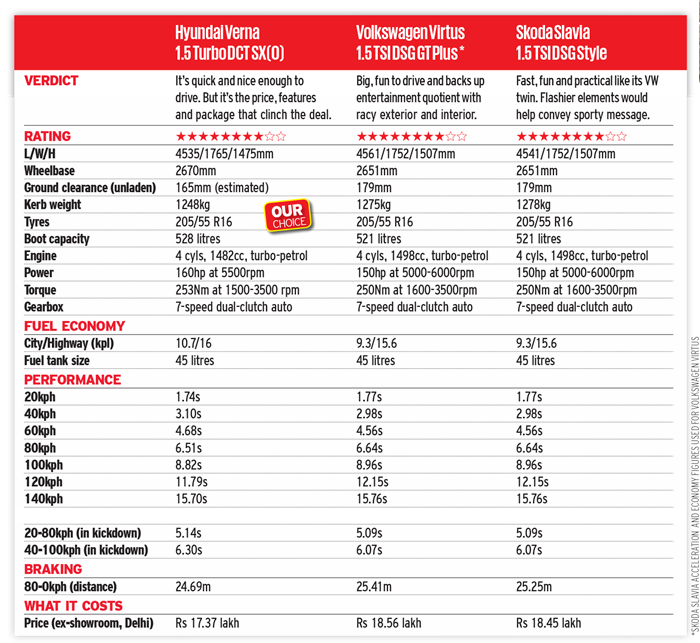
Also see:
Hyundai Verna vs Skoda Slavia vs Volkswagen Virtus video comparison
Copyright (c) Autocar India. All rights reserved.


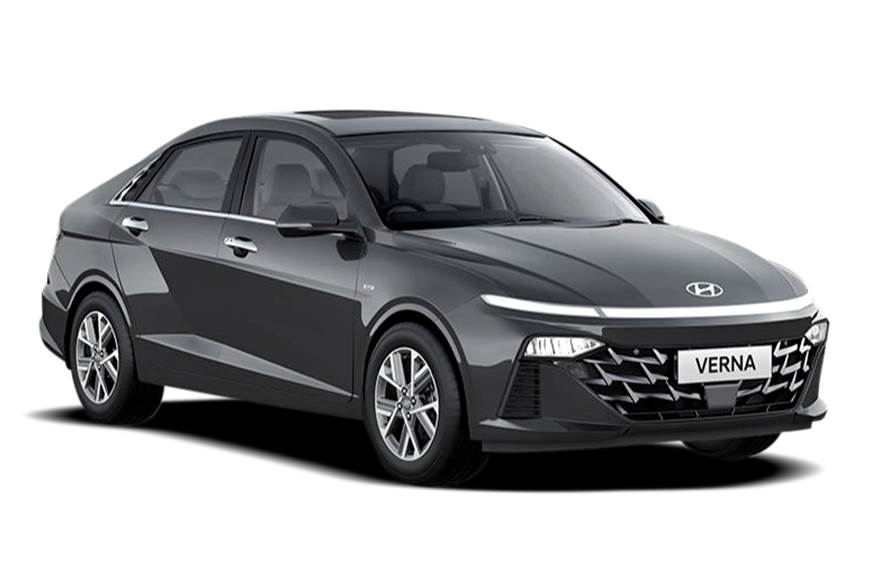
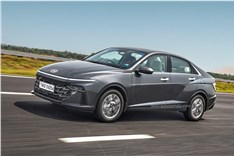
.jpg&w=234&h=156&q=90&c=1)
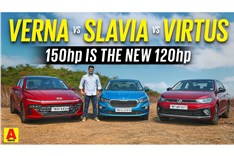



Comments
Member Login
Personal Details
No comments yet. Be the first to comment.